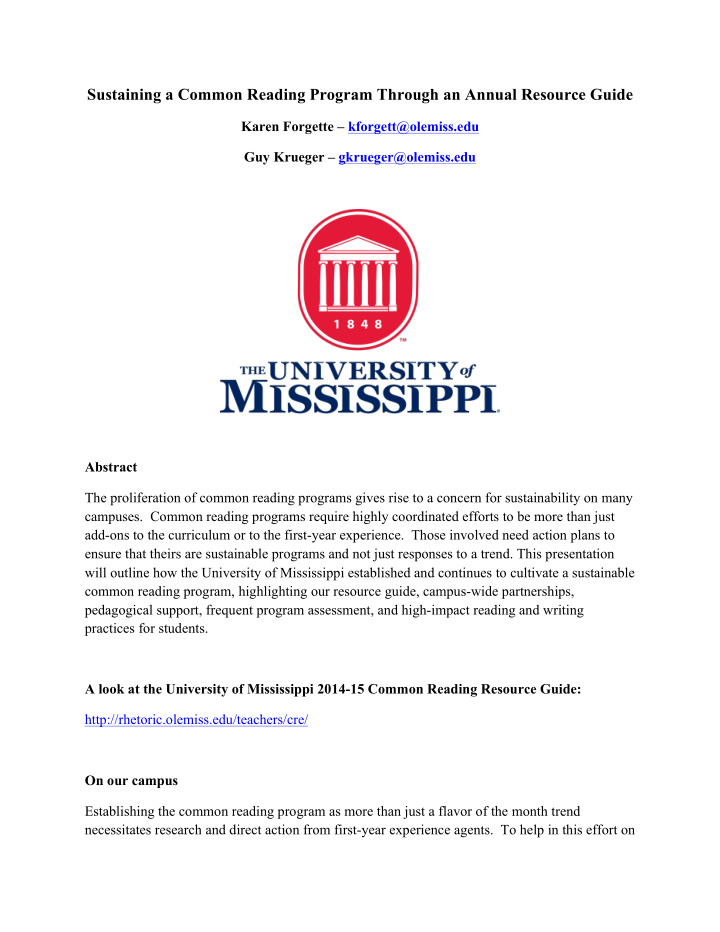



Sustaining a Common Reading Program Through an Annual Resource Guide Karen Forgette – kforgett@olemiss.edu Guy Krueger – gkrueger@olemiss.edu Abstract The proliferation of common reading programs gives rise to a concern for sustainability on many campuses. Common reading programs require highly coordinated efforts to be more than just add-ons to the curriculum or to the first-year experience. Those involved need action plans to ensure that theirs are sustainable programs and not just responses to a trend. This presentation will outline how the University of Mississippi established and continues to cultivate a sustainable common reading program, highlighting our resource guide, campus-wide partnerships, pedagogical support, frequent program assessment, and high-impact reading and writing practices for students. A look at the University of Mississippi 2014-15 Common Reading Resource Guide: http://rhetoric.olemiss.edu/teachers/cre/ On our campus Establishing the common reading program as more than just a flavor of the month trend necessitates research and direct action from first-year experience agents. To help in this effort on
our campus, in 2011-12, instructors in our first-year composition program teamed with first-year experience seminar instructors to compose a resource guide for teachers as a supplement to the common reading text. In subsequent years, the continuing work of the resource guide committee and the guide itself have helped to successfully seed the common read program in a variety of campus and community venues. To build pedagogical support, the committee annually composes a resource guide that includes suggestions for general classroom practices, rationale for the common read program and the text selection, and methods for building instruction around the book’s themes. Additionally, the committee facilitates two types of workshops for first-year experience seminar instructors, one on the teaching of writing and one on incorporating the common reading text into the classroom. To increase investment across the campus and community, the committee invites faculty members with expertise in areas related to the text to compose sections of the guide. For example, for last year’s guide on The Unforgiving Minute , a memoir about a soldier’s experiences in Afghanistan, an ROTC instructor wrote a primer on military terminology. For this year’s guide on The Girls of Atomic City , a physics professor wrote a section on the basics of nuclear physics and energy. Additionally, one committee member is a librarian who develops and publicizes campus and community-wide events related to the common read, thereby increasing awareness and scope of the program. This cross-disciplinary interaction has increased faculty interest across campus in the common reading program. Finally, we gather student and instructor feedback on the common reading text, the resource guide, and campus-wide events. We use this assessment data to guide committee discussions on future first-year experience decisions related to the common reading and the resource guide. These discussions often generate fresh insights for keeping multiple parties involved and sustaining the program. Recommendations To ensure a healthy Common Reading program with long-term sustainability, we recommend the following: (1) Identify a dedicated group of two-three committee members who will be a part of the resource guide’s creation each year to help plan, organize, troubleshoot, and draw from previous experience. This team can help provide leadership and continuity; (2) Rotate in other faculty/staff on campus to help work on the guide’s creation. In particular, try to recruit a variety of members, including people who work closely with first-year students and those from departments who may have specialized expertise related to a theme from the common reading text; (3) Involve the campus library. Librarians can be helpful in designing work related to the common reading text but also in locating supplementary readings and media. Further, the library may serve as a hub for connection to the community at large; (4) Assess the program often and from multiple sources including students, instructors, and stakeholders.
Recommend
More recommend